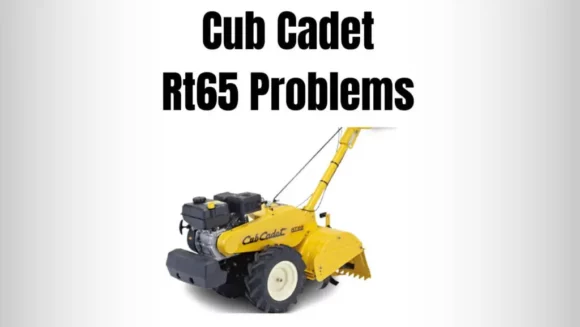
The Cub Cadet RT65 is a rear-tine tiller designed for heavy-duty garden and landscaping work. With a robust 208cc OHV engine, counter-rotating tines, and a 18-inch tilling width, the RT65 is widely used by serious gardeners and small-scale farmers. However, like most mechanical equipment, the RT65 isn’t free from problems — especially as it ages.
This guide breaks down the most common Cub Cadet RT65 problems, their causes and solutions, how to maintain your tiller, and when repairs may not be worth it. You’ll also find technical specifications, parts info, and an FAQ section to help you get the most from your machine.
Cub Cadet RT65 Tiller Specifications
| Feature | Details |
|---|---|
| Engine | 208cc Cub Cadet OHV |
| Tine Rotation | Counter-rotating |
| Tilling Width | 18 inches |
| Tilling Depth | Up to 7 inches |
| Transmission | Chain drive, 1 forward / 1 reverse |
| Tires | 13″ AG tread |
| Fuel Capacity | 3 quarts |
| Weight | Approx. 200 lbs |
| Drive Type | Rear tine, self-propelled |
Most Common Cub Cadet RT65 Problems and Fixes
1. Engine Won’t Start
Symptoms:
- Pull cord feels normal but engine doesn’t fire
- No sputter or sign of combustion
Possible Causes:
- Old or stale fuel
- Clogged carburetor
- Dirty or faulty spark plug
- Safety switch not engaged
- Ignition coil failure
Fixes:
- Drain old fuel and replace with fresh gasoline (preferably ethanol-free).
- Clean or rebuild the carburetor if it’s gummed up (especially after storage).
- Replace the spark plug (use an OEM plug, properly gapped to 0.030″).
- Check safety switches (including the reverse gear lever or PTO disconnect).
- Test for spark — if none, inspect or replace the ignition coil.
Pro Tip: Always add fuel stabilizer when storing for more than 30 days.
2. Tiller Starts But Stalls After a Few Seconds
Symptoms:
- Tiller starts, runs briefly, then dies
- May stall faster when engaging the tines or throttle
Causes:
- Blocked fuel lines or fuel filter
- Gummed carburetor jets
- Venting issue in fuel cap
- Dirty air filter
- Governor problems
Fixes:
- Check and clean fuel filter (inside or just outside the tank).
- Inspect fuel lines for cracks or clogs — replace if needed.
- Clean carburetor jets with compressed air and cleaner.
- Try loosening the fuel cap slightly to see if a vacuum is causing fuel starvation.
- Clean or replace the air filter to ensure good airflow.
3. Tines Won’t Turn
Symptoms:
- Engine runs, wheels move, but tines don’t rotate
- Grinding or clicking noises from tine housing
Causes:
- Broken shear pin
- Damaged tine gear or shaft
- Disconnected or worn chain drive
- Transmission issue
Fixes:
- Inspect the shear pins on the tine shaft (these are designed to break under overload).
- Check inside the tine housing for debris or damage.
- If chain drive is the issue, open the case (requires mechanical skill) and inspect for wear or damage. Replace as necessary.
- Lubricate the transmission as per manual — lack of lube can wear internal components.
4. Wheels Move, But Tiller Doesn’t Pull Forward
Symptoms:
- Tines spin, engine runs, but tiller doesn’t move forward properly
- Slips when encountering resistance
Causes:
- Drive belt is slipping
- Transmission issue
- Drive cable out of adjustment
- Worn wheel gears or stripped splines
Fixes:
- Inspect and tighten or replace the drive belt — a common wear item.
- Adjust or replace the drive cable — if stretched, it won’t engage properly.
- If gears are stripped, check wheel hubs and shafts — replacement may be required.
5. Excessive Vibration or Noise
Symptoms:
- Loud knocking or vibration during operation
- Shaking handles or bouncing tiller
Causes:
- Loose bolts or engine mounts
- Worn tine shaft bearings
- Unbalanced or bent tines
- Engine misfiring
Fixes:
- Tighten all frame and engine bolts.
- Inspect tines for bends — replace if damaged.
- Replace bearings if there’s side-to-side shaft play.
- Clean or replace the spark plug to ensure smooth firing.
6. Tiller Leaking Oil or Grease
Symptoms:
- Visible oil under the unit
- Oil on tines or transmission case
Causes:
- Worn seals or gaskets
- Overfilled gearcase
- Cracked housing
Fixes:
- Inspect seals around the tine shaft and wheel shaft.
- Drain excess oil if overfilled.
- Replace gaskets if leaking at split-case seam.
- If housing is cracked, you may need a replacement transmission case.
7. Hard to Shift Between Gears
Symptoms:
- Gear lever sticks
- Grinding when shifting
- Reverse doesn’t engage
Causes:
- Dirty or corroded shift linkage
- Damaged transmission gear
- Misaligned gear selector fork
Fixes:
- Lubricate the gear shift lever and linkage.
- Remove debris from the transmission housing.
- For internal transmission issues, disassembly is required — may need professional repair.
8. Tiller Moves While in Neutral
Symptoms:
- Tiller creeps forward or backward without engaging drive
- Hard to control in tight spaces
Causes:
- Drive cable out of adjustment
- Transmission engagement issue
- Misadjusted clutch tension
Fixes:
- Adjust or replace the drive cable using the tensioning screw.
- Inspect clutch spring and cable linkage.
- In rare cases, internal transmission components may be partially engaged — service required.

Preventive Maintenance Tips
Regular maintenance is the key to preventing most Cub Cadet RT65 issues.
Every Use:
- Check oil level
- Clean debris from tines and belt housing
- Inspect for loose bolts or wires
Every 10 Hours:
- Clean air filter
- Check spark plug condition
- Inspect fuel lines and connections
Every 25 Hours:
- Change engine oil (SAE 10W-30)
- Lubricate tine shaft and wheel axles
Annually (or every 50 hours):
- Replace spark plug
- Clean fuel system and carburetor
- Check drive and tine belts
- Grease wheel shaft and tiller bushings
Replacement Parts and Part Numbers
| Part | Part Number |
|---|---|
| Air Filter | 751-10298 |
| Spark Plug | 951-10292 (NGK BPR6ES equivalent) |
| Drive Belt | 954-04001 |
| Tine Belt | 954-04201 |
| Shear Pins | 738-04124A |
| Carburetor Assembly | 951-14026 |
| Tine Assembly | 742-04126 |
When to Repair vs. Replace
If your Cub Cadet RT65 has:
- Engine damage (broken rod, seized piston)
- Multiple gear or transmission failures
- Cracked main housing
…it may be more economical to replace the unit, especially if it’s over 10 years old. However, for most issues like belts, carburetors, or tines, replacement parts are affordable and available.
Cub Cadet RT65 Tiller FAQs
Q: What is the correct oil type for the RT65?
A: Use SAE 10W-30 4-cycle engine oil. Avoid using 2-stroke oil.
Q: Why do my tines stop under load?
A: The belt may be slipping, the shear pin may be broken, or the tine shaft may be damaged.
Q: How deep can the RT65 till?
A: Up to 7 inches, depending on soil condition and tine wear.
Q: How do I adjust tilling depth?
A: By raising or lowering the depth stake at the rear of the tiller.
Q: Can I use ethanol gas in the RT65?
A: Yes, but it’s recommended to use ethanol-free fuel or add a stabilizer to prevent carb issues.
Q: My tiller won’t reverse — why?
A: Check if the reverse cable is engaging fully. Also inspect for debris or gear issues in the transmission.
Final Thoughts
The Cub Cadet RT65 is a powerful and dependable tiller when properly maintained. While problems like carburetor issues, drive belt wear, and tine failure are common with use, they are usually easy to fix with basic tools and parts. Regular maintenance, timely part replacements, and storing the tiller properly in the off-season will go a long way in extending its lifespan.
If your tiller shows signs of multiple failures — especially transmission or engine damage — evaluate repair costs versus buying a new machine. For the average home gardener, however, the RT65 remains a great investment when maintained correctly.

I’m David man behind Lawn Mowerly; I’ve been dealing with lawnmowers and Tractors with my father since I was a kid. I know every make and model and what each one is capable of and love helping people find the perfect equipment for their needs.
